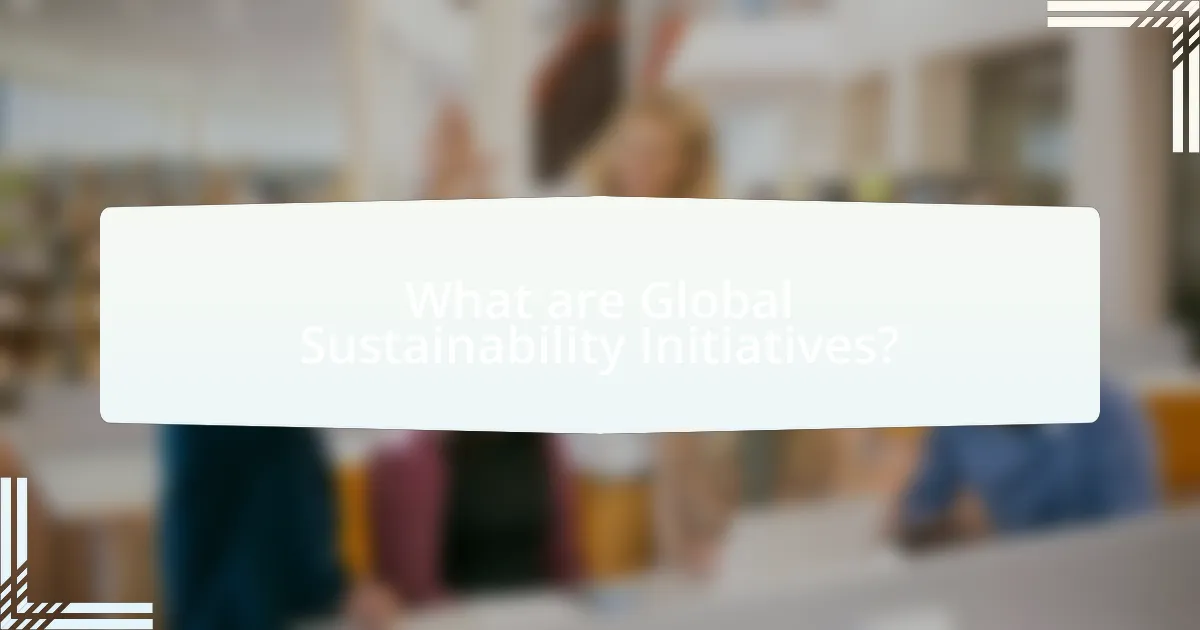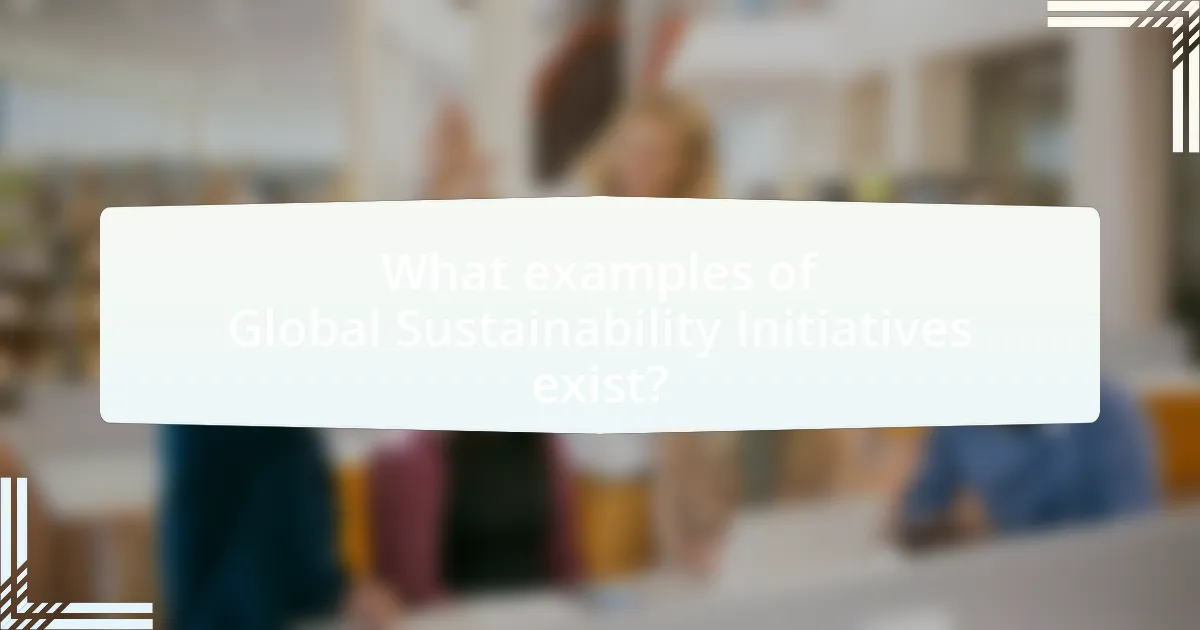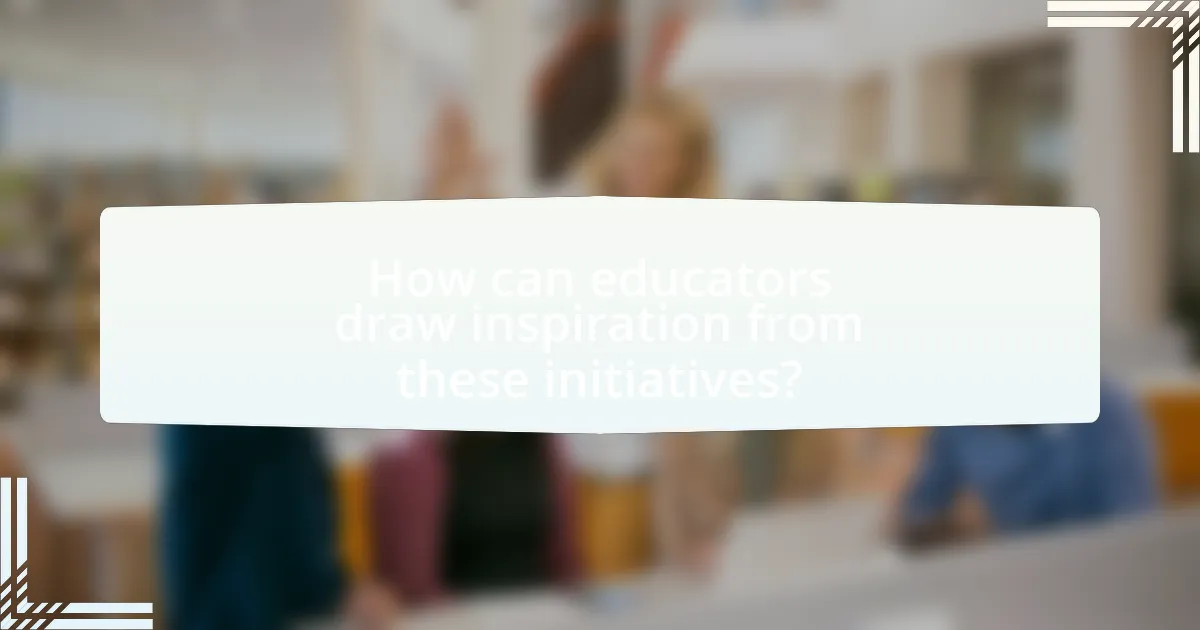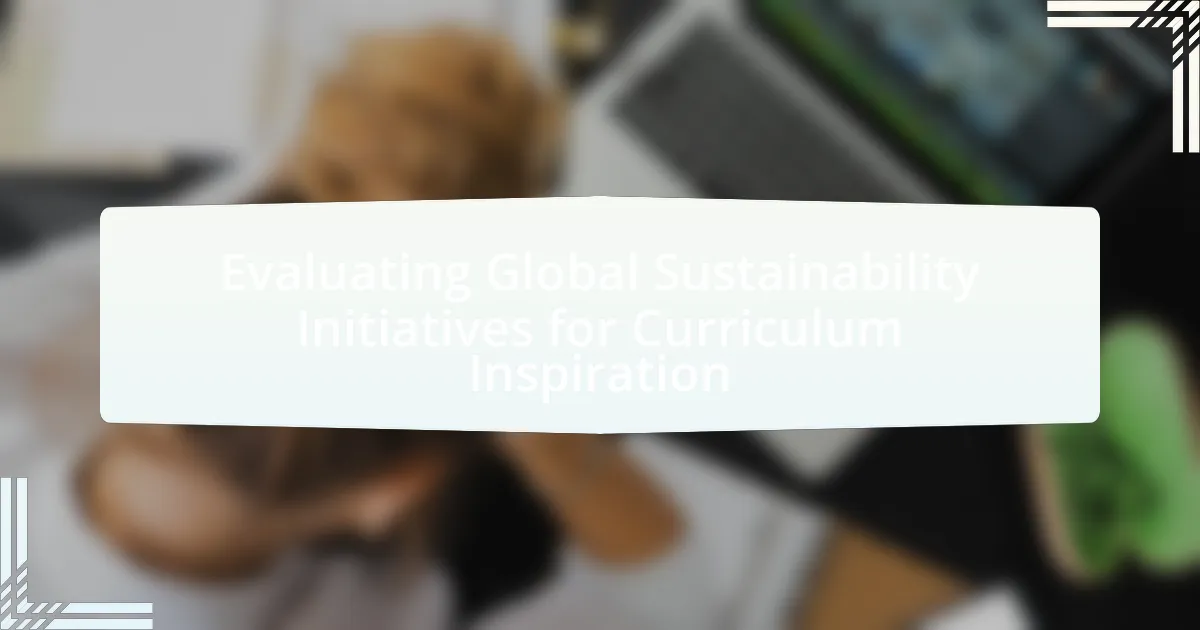Global Sustainability Initiatives are organized efforts aimed at fostering sustainable development worldwide, addressing critical environmental, social, and economic issues. This article evaluates the impact of these initiatives, particularly the United Nations Sustainable Development Goals (SDGs), on education by integrating sustainability concepts into curricula and promoting interdisciplinary approaches. It discusses key principles of sustainability in education, the importance of evaluating initiatives, and the criteria for assessment, while also highlighting successful case studies and the role of various organizations in promoting sustainability. Additionally, it explores strategies for curriculum development, the significance of community collaboration, and the challenges educators face in implementing these initiatives.

What are Global Sustainability Initiatives?
Global Sustainability Initiatives are coordinated efforts aimed at promoting sustainable development on a global scale, addressing environmental, social, and economic challenges. These initiatives include frameworks like the United Nations Sustainable Development Goals (SDGs), which consist of 17 goals established in 2015 to tackle issues such as poverty, inequality, and climate change. The SDGs serve as a universal call to action for countries, organizations, and individuals to work collaboratively towards a more sustainable future, with specific targets and indicators to measure progress.
How do Global Sustainability Initiatives impact education?
Global Sustainability Initiatives significantly enhance education by integrating sustainability concepts into curricula, promoting critical thinking and problem-solving skills among students. These initiatives encourage educational institutions to adopt interdisciplinary approaches, fostering collaboration across subjects such as science, social studies, and economics. For instance, the United Nations’ Sustainable Development Goals (SDGs) provide a framework that educational systems can use to align their teaching with global sustainability challenges, thereby preparing students to address real-world issues. Research indicates that schools implementing sustainability-focused programs report increased student engagement and awareness of environmental issues, demonstrating the positive impact of these initiatives on educational outcomes.
What are the key principles of sustainability in education?
The key principles of sustainability in education include holistic learning, interdisciplinary approaches, community engagement, and critical thinking. Holistic learning emphasizes the interconnectedness of social, economic, and environmental systems, fostering a comprehensive understanding of sustainability. Interdisciplinary approaches integrate knowledge from various fields, enabling students to address complex sustainability challenges effectively. Community engagement involves collaboration with local stakeholders to enhance real-world relevance and impact. Critical thinking encourages students to analyze and evaluate information, promoting informed decision-making regarding sustainability issues. These principles are supported by educational frameworks such as the United Nations Sustainable Development Goals, which advocate for quality education that empowers individuals to contribute to sustainable development.
How do these principles translate into curriculum development?
The principles of evaluating global sustainability initiatives translate into curriculum development by integrating sustainability concepts into educational frameworks. This integration involves aligning learning objectives with real-world sustainability challenges, ensuring that students engage with relevant issues such as climate change, resource management, and social equity. For instance, the United Nations Sustainable Development Goals (SDGs) provide a structured approach for curriculum developers to incorporate global sustainability themes, fostering critical thinking and problem-solving skills among students. By utilizing case studies from successful sustainability initiatives, educators can create experiential learning opportunities that connect theoretical knowledge with practical applications, thereby enhancing student engagement and understanding of sustainability in a global context.
Why is it important to evaluate these initiatives?
Evaluating global sustainability initiatives is crucial for understanding their effectiveness and impact. This assessment allows educators and policymakers to identify successful strategies and practices that can be integrated into curricula. For instance, a study by the United Nations Educational, Scientific and Cultural Organization (UNESCO) highlights that evaluating educational initiatives can lead to improved learning outcomes and greater engagement in sustainability topics. By analyzing data from various programs, stakeholders can make informed decisions that enhance educational frameworks and promote sustainable development goals.
What criteria should be used for evaluating sustainability initiatives?
The criteria for evaluating sustainability initiatives include environmental impact, social equity, economic viability, stakeholder engagement, and scalability. Environmental impact assesses the initiative’s effect on natural resources and ecosystems, while social equity examines how benefits and burdens are distributed among different communities. Economic viability evaluates the financial sustainability and cost-effectiveness of the initiative. Stakeholder engagement measures the involvement of affected parties in the planning and implementation processes. Scalability considers the potential for the initiative to be expanded or replicated in different contexts. These criteria are essential for ensuring that sustainability initiatives are comprehensive, effective, and beneficial across multiple dimensions.
How can evaluation lead to improved educational outcomes?
Evaluation can lead to improved educational outcomes by providing data-driven insights that inform teaching practices and curriculum development. When educators assess student performance and learning processes, they can identify strengths and weaknesses, allowing for targeted interventions. For instance, a study by Black and Wiliam (1998) demonstrated that formative assessment significantly enhances student achievement by enabling teachers to adjust instruction based on real-time feedback. This iterative process of evaluation fosters a responsive educational environment, ultimately leading to better student engagement and higher academic performance.

What examples of Global Sustainability Initiatives exist?
Examples of global sustainability initiatives include the United Nations Sustainable Development Goals (SDGs), the Paris Agreement on climate change, and the Global Covenant of Mayors for Climate and Energy. The SDGs, adopted in 2015, consist of 17 goals aimed at addressing global challenges such as poverty, inequality, and climate change, with specific targets to be achieved by 2030. The Paris Agreement, established in 2016, commits countries to limit global warming to well below 2 degrees Celsius, promoting international cooperation in reducing greenhouse gas emissions. The Global Covenant of Mayors for Climate and Energy unites cities worldwide in their efforts to combat climate change and promote sustainable energy solutions, demonstrating a collective commitment to local action for global impact.
How do different countries implement sustainability in their curricula?
Different countries implement sustainability in their curricula through various approaches tailored to their specific educational systems and cultural contexts. For instance, Finland integrates sustainability education across all subjects, emphasizing environmental responsibility and critical thinking from an early age. In contrast, Canada promotes sustainability through its “Education for Sustainable Development” framework, which encourages schools to incorporate local environmental issues into their teaching. Additionally, Germany has established a national strategy that mandates sustainability education in schools, focusing on practical projects and community involvement. These implementations are supported by research indicating that integrating sustainability into education enhances students’ awareness and engagement with environmental issues, as seen in studies conducted by the United Nations Educational, Scientific and Cultural Organization (UNESCO).
What are some successful case studies from various regions?
Successful case studies from various regions include the Solar Schools Initiative in Australia, which has led to over 1,000 schools adopting solar energy, resulting in significant reductions in carbon emissions and energy costs. In Sweden, the city of Malmö implemented a sustainable urban development project that transformed a former industrial area into a vibrant eco-friendly community, showcasing effective waste management and energy-efficient buildings. Additionally, the Green Roofs project in Chicago has demonstrated the benefits of urban greening, improving air quality and reducing urban heat while enhancing biodiversity. These examples illustrate effective sustainability practices that can inspire educational curricula globally.
How do cultural differences influence sustainability education?
Cultural differences significantly influence sustainability education by shaping values, beliefs, and practices related to environmental stewardship. For instance, collectivist cultures often emphasize community-based approaches to sustainability, fostering collaboration and shared responsibility, while individualistic cultures may focus on personal accountability and innovation. Research by UNESCO highlights that culturally relevant pedagogy enhances engagement and effectiveness in sustainability education, as it aligns educational content with local customs and traditions. This alignment not only increases the relevance of sustainability concepts but also encourages active participation from learners, thereby improving educational outcomes.
What types of organizations are involved in these initiatives?
Various types of organizations are involved in global sustainability initiatives, including non-governmental organizations (NGOs), governmental agencies, educational institutions, and private sector companies. NGOs like Greenpeace and the World Wildlife Fund focus on environmental advocacy and awareness, while governmental agencies implement policies and regulations to promote sustainability. Educational institutions contribute by integrating sustainability into their curricula and research. Private sector companies engage in corporate social responsibility initiatives aimed at reducing their environmental impact. These organizations collaborate to address sustainability challenges and promote best practices across different sectors.
Which NGOs play a significant role in promoting sustainability in education?
Several NGOs play a significant role in promoting sustainability in education, including the Global Partnership for Education, the Earth Day Network, and the World Wildlife Fund. The Global Partnership for Education focuses on ensuring inclusive and equitable quality education, emphasizing sustainability in its initiatives. The Earth Day Network promotes environmental education and awareness, engaging millions in sustainability efforts. The World Wildlife Fund integrates sustainability into educational programs, advocating for conservation and responsible resource management. These organizations contribute to a global movement that enhances educational curricula with sustainability principles, fostering a more environmentally conscious generation.
How do governmental policies support sustainability initiatives?
Governmental policies support sustainability initiatives by providing regulatory frameworks, financial incentives, and public awareness campaigns that promote environmentally friendly practices. For instance, policies such as the Paris Agreement set international climate goals, encouraging countries to adopt renewable energy sources and reduce greenhouse gas emissions. Additionally, governments often implement subsidies for solar and wind energy projects, making them more economically viable. According to the International Renewable Energy Agency, global renewable energy capacity increased by 10.3% in 2020, largely due to supportive government policies. These measures not only facilitate the transition to sustainable practices but also foster innovation and investment in green technologies.

How can educators draw inspiration from these initiatives?
Educators can draw inspiration from global sustainability initiatives by integrating successful practices and frameworks into their curricula. For instance, initiatives like the United Nations Sustainable Development Goals (SDGs) provide a structured approach to teaching sustainability, encouraging educators to incorporate real-world issues into lesson plans. Research shows that schools implementing SDG-related projects report increased student engagement and awareness of global challenges, demonstrating the effectiveness of such initiatives in fostering critical thinking and problem-solving skills. By adapting these frameworks, educators can create relevant and impactful learning experiences that resonate with students and promote sustainability.
What strategies can be employed to integrate sustainability into existing curricula?
To integrate sustainability into existing curricula, educators can employ strategies such as interdisciplinary approaches, project-based learning, and community partnerships. Interdisciplinary approaches allow for the incorporation of sustainability concepts across various subjects, enhancing students’ understanding of its relevance in different contexts. Project-based learning engages students in real-world sustainability challenges, fostering critical thinking and problem-solving skills. Community partnerships provide opportunities for students to collaborate with local organizations, reinforcing the practical application of sustainability principles. Research indicates that these strategies not only improve student engagement but also lead to a deeper understanding of sustainability issues, as demonstrated by programs like the Eco-Schools initiative, which has successfully integrated sustainability into curricula in over 60 countries.
How can project-based learning enhance sustainability education?
Project-based learning enhances sustainability education by actively engaging students in real-world environmental challenges, fostering critical thinking and problem-solving skills. This hands-on approach allows learners to collaborate on projects that address local sustainability issues, such as waste management or renewable energy solutions. Research indicates that students involved in project-based learning demonstrate higher retention of knowledge and a greater understanding of sustainability concepts, as they apply theoretical knowledge to practical situations. For instance, a study published in the Journal of Environmental Education Research found that students participating in project-based learning initiatives showed a 30% increase in their ability to identify sustainable practices compared to traditional learning methods.
What role does interdisciplinary teaching play in sustainability?
Interdisciplinary teaching plays a crucial role in sustainability by integrating knowledge and methods from various disciplines to address complex environmental challenges. This approach fosters critical thinking and problem-solving skills, enabling students to understand the interconnectedness of social, economic, and ecological systems. Research indicates that interdisciplinary curricula enhance student engagement and retention of sustainability concepts, as evidenced by a study published in the Journal of Environmental Education, which found that students exposed to interdisciplinary teaching demonstrated a 30% increase in their understanding of sustainability issues compared to those in traditional, single-discipline courses.
What resources are available for educators seeking to implement sustainability initiatives?
Educators seeking to implement sustainability initiatives can access a variety of resources, including online platforms, curriculum guides, and professional development programs. Notable online platforms such as the Sustainability Education Toolkit provide educators with lesson plans, activities, and case studies focused on sustainability. Additionally, organizations like the National Geographic Society offer resources and grants specifically aimed at integrating sustainability into educational curricula. Research indicates that schools implementing sustainability initiatives see improved student engagement and awareness, as highlighted in the “Impact of Sustainability Education on Student Engagement” study published by the Journal of Environmental Education Research.
Which online platforms provide valuable materials and support?
Online platforms that provide valuable materials and support for evaluating global sustainability initiatives include Coursera, edX, and Khan Academy. Coursera offers courses from universities worldwide, focusing on sustainability topics, while edX provides access to a range of sustainability-related courses and resources from reputable institutions. Khan Academy features educational videos and exercises that cover environmental science and sustainability concepts, making it a useful resource for learners. These platforms collectively enhance understanding and provide structured learning opportunities in sustainability.
How can collaboration with local communities enhance curriculum development?
Collaboration with local communities enhances curriculum development by integrating real-world perspectives and local knowledge into educational content. This approach ensures that the curriculum is relevant and responsive to the needs and values of the community, fostering greater engagement among students. For instance, research conducted by the National Education Association highlights that when schools partner with local organizations, they can incorporate community issues, such as environmental sustainability, into the curriculum, making learning more applicable and impactful. This collaboration not only enriches the educational experience but also strengthens community ties and promotes a sense of shared responsibility for local challenges.
What are best practices for evaluating and adapting sustainability initiatives in education?
Best practices for evaluating and adapting sustainability initiatives in education include establishing clear metrics for assessment, engaging stakeholders, and incorporating feedback mechanisms. Clear metrics, such as student engagement levels and environmental impact assessments, provide quantifiable data to measure the effectiveness of initiatives. Engaging stakeholders, including students, educators, and community members, ensures diverse perspectives are considered, fostering a more inclusive approach. Feedback mechanisms, such as surveys and focus groups, allow for continuous improvement by capturing insights on the initiative’s strengths and weaknesses. These practices are supported by research indicating that participatory evaluation enhances the relevance and effectiveness of educational programs (Cousins & Earl, 1995, “Participatory Evaluation in Education: A Guide for Educators”).
How can feedback mechanisms improve the effectiveness of sustainability curricula?
Feedback mechanisms can enhance the effectiveness of sustainability curricula by facilitating continuous improvement through real-time data collection and analysis. These mechanisms allow educators to gather insights from students, stakeholders, and the community, enabling them to identify strengths and weaknesses in the curriculum. For instance, studies have shown that incorporating student feedback leads to a 20% increase in engagement and retention rates in sustainability courses, as it aligns the curriculum with learners’ interests and needs. By systematically integrating feedback, curricula can be adapted to reflect current sustainability challenges and innovations, ensuring relevance and effectiveness in achieving educational goals.
What common challenges do educators face when implementing these initiatives?
Educators commonly face challenges such as limited resources, lack of training, and resistance to change when implementing sustainability initiatives in their curricula. Limited resources, including insufficient funding and materials, hinder the ability to effectively integrate these initiatives. Additionally, many educators lack adequate training in sustainability concepts, which can lead to ineffective teaching practices. Resistance to change from both faculty and students can also impede the adoption of new curricula, as established routines and mindsets are difficult to alter. These challenges are documented in various studies, including the “Sustainability in Education: A Review of the Literature” by the Journal of Education for Sustainable Development, which highlights the barriers educators encounter in promoting sustainability in educational settings.

Leave a Reply